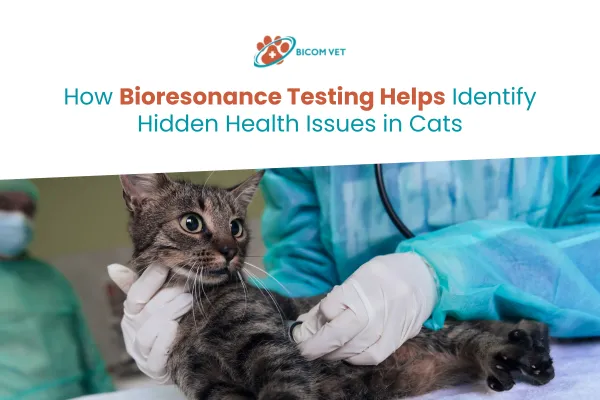
Bioresonance Testing for Cats: Detect Hidden Health Issues
How Bioresonance Testing Helps Identify Hidden Health Issues in Cats
Cats are masters of hiding pain and illness. Their instinct to conceal vulnerability often means serious health issues go undetected until they become critical. This silent suffering can be heartbreaking for pet owners who want the best for their feline companions.
Fortunately, modern veterinary medicine offers innovative solutions. Bioresonance testing has emerged as a powerful tool for identifying hidden health problems in cats before they manifest as visible symptoms.
What Is Bioresonance Testing?
Bioresonance testing represents a breakthrough in veterinary diagnostics. This non-invasive technology uses electromagnetic frequencies to assess your cat's health at a cellular level.
The process works by measuring the body's natural electromagnetic field. Every cell, organ, and system in your cat's body emits specific frequencies. When illness or imbalance occurs, these frequencies change in detectable ways.
Unlike traditional diagnostic methods that often require blood draws or invasive procedures, bioresonance testing is completely stress-free for your cat. The BICOM® device simply reads your pet's electromagnetic signature, providing valuable insights into their health status.
Why Cats Hide Their Health Problems
Understanding feline behavior is crucial for pet owners. Cats evolved as both predators and prey, developing sophisticated survival mechanisms that persist to this day.
Natural Instincts at Work
Wild cats that showed weakness became vulnerable to predators or lost their hunting abilities. This evolutionary pressure created cats that instinctively mask pain and illness.
Your domestic cat retains these same instincts. They may continue eating, playing, and appearing normal even when experiencing significant discomfort or disease.
Common Signs Pet Owners Miss
Subtle changes in behavior often indicate underlying health issues:
Slight changes in appetite or eating patterns
Minor alterations in sleep habits
Decreased grooming frequency
Reduced interaction with family members
Small changes in litter box habits
These early warning signs are easily overlooked, especially in busy households. By the time obvious symptoms appear, conditions may have progressed significantly.
How Bioresonance Testing Detects Hidden Issues
The beauty of bioresonance testing lies in its ability to detect imbalances before they become clinical symptoms. This early detection capability makes it an invaluable tool for proactive cat care.
Cellular-Level Assessment
Traditional veterinary examinations rely on observable symptoms or detectable changes in blood work. Bioresonance testing goes deeper, examining how your cat's cells and organs function at the electromagnetic level.
This approach can identify:
Nutritional deficiencies affecting organ function
Environmental toxins impacting cellular health
Immune system weaknesses
Digestive imbalances
Stress-related physiological changes
Non-Invasive Diagnostic Advantage
Most cats experience stress during veterinary visits. Blood draws, physical restraint, and unfamiliar environments can spike cortisol levels, potentially affecting test results.
Bioresonance testing eliminates this stress factor. The process is gentle and quiet, allowing for more accurate readings of your cat's natural state.
Common Hidden Health Issues in Cats
Certain conditions frequently go undiagnosed in cats until they reach advanced stages. Bioresonance testing can identify these problems early, when treatment is most effective.
Kidney Disease
Chronic kidney disease affects up to 30% of senior cats. Traditional blood tests only detect kidney problems after 75% of function is lost.
Bioresonance testing can identify kidney stress patterns before significant damage occurs. Early detection allows for dietary modifications and treatments that can slow disease progression.
Digestive Disorders
Cats commonly suffer from inflammatory bowel disease, food sensitivities, and parasites. These conditions often present with subtle symptoms that owners attribute to pickiness or stress.
The electromagnetic signatures of digestive imbalances are distinct and detectable through bioresonance testing. This allows for targeted treatment before chronic inflammation develops.
Hormonal Imbalances
Thyroid disorders, particularly hyperthyroidism, are common in middle-aged and senior cats. Early stages may only cause slight increases in appetite or activity levels.
Bioresonance testing can detect hormonal fluctuations before they become clinically apparent, allowing for earlier intervention and improved outcomes.
Benefits for Your Cat's Wellness
Regular bioresonance testing provides numerous benefits for maintaining your cat's health and detecting potential issues early.
Stress-Free Health Monitoring
The gentle nature of bioresonance testing means your cat won't experience the anxiety associated with traditional diagnostic procedures. This is particularly beneficial for sensitive or elderly cats.
Comprehensive Health Picture
While blood work provides a snapshot of specific parameters, bioresonance testing offers a holistic view of your cat's health. It examines how various body systems interact and influence one another.
Preventive Care Approach
Instead of waiting for symptoms to appear, bioresonance testing enables proactive health management. You can address imbalances before they develop into severe conditions.
How the Testing Process Works
Understanding what to expect during bioresonance testing helps you prepare your cat for the appointment.
Initial Consultation
Your veterinarian will discuss your cat's health history, behavior patterns, and any concerns you've noticed. This information helps guide the testing process.
The Testing Session
Your cat will be positioned comfortably near the BICOM® device. The testing is silent and requires no restraint or sedation. Most cats remain calm throughout the process.
Results Interpretation
The device generates detailed reports showing your cat's electromagnetic patterns. Your veterinarian will explain the findings and recommend appropriate treatments or lifestyle modifications.
Integrating Bioresonance Testing into Cat Care
Bioresonance testing is most effective when used as part of a comprehensive healthcare approach, rather than as a standalone diagnostic tool.
Complementing Traditional Medicine
While bioresonance testing provides valuable insights, it doesn't replace standard veterinary care. Blood work, physical examinations, and imaging studies remain essential diagnostic tools.
The combination of traditional and bioresonance testing creates a more complete picture of your cat's health status.
Optimal Testing Frequency
Most cats benefit from bioresonance testing every 6 to 12 months, depending on their age and health status. Senior cats or those with chronic conditions may need more frequent monitoring.
Supporting Your Cat's Health Journey
Beyond diagnostic testing, you can take steps to support your cat's overall well-being and make the most of the insights from bioresonance testing.
Environmental Optimization
Create a stress-free environment that supports your cat's natural behaviors. Provide quiet spaces, appropriate scratching surfaces, and consistent routines.
Nutritional Support
High-quality nutrition forms the foundation of good health. Work with your veterinarian to select foods that cater to your cat's specific needs and any conditions identified through testing.
Regular Monitoring
Keep detailed records of your cat's behavior, appetite, and habits. This information helps your veterinarian interpret bioresonance testing results and track changes over time.
Conclusion
Bioresonance testing represents a significant advancement in feline healthcare. By detecting hidden health issues before they become serious problems, this technology enables pet owners to provide more effective care for their cats.
The non-invasive nature of bioresonance testing makes it an ideal addition to your cat's healthcare routine. Combined with traditional veterinary care, it offers a comprehensive approach to maintaining your feline's health and happiness.
If you're concerned about your cat's health or interested in proactive wellness monitoring, consider discussing bioresonance testing with your veterinarian. This innovative technology could be the key to uncovering hidden health issues and ensuring your cat enjoys a long, healthy life.
At Bioresonance Vet, we're committed to advancing animal health through innovative diagnostic technologies. Our BICOM® devices provide veterinarians with powerful tools to detect and address health issues before they compromise your pet's quality of life.
Frequently Asked Questions
1. Is this electromagnetic frequency assessment safe for my cat?
Yes, this diagnostic method is entirely safe and non-invasive for cats of all ages. The electromagnetic frequencies used are gentle and cause no discomfort or side effects to your feline companion.
2. How long does a typical health assessment session take?
A standard session usually takes 30-45 minutes, including consultation and result interpretation. The actual electromagnetic scanning process is quick and stress-free for your cat.
3. Can this technology replace my regular veterinary checkups?
No, this diagnostic tool works best in conjunction with traditional veterinary care and routine check-ups. It provides additional insights that complement standard blood work and physical examinations.
4. At what age should I start using this health monitoring for my cat?
You can begin using this technology at any age, though it's particularly beneficial for senior cats over 7 years old. Early detection becomes increasingly essential as cats age and naturally hide health issues.
5. Will my cat need to be sedated during the electromagnetic assessment?
No sedation is required as the process is completely stress-free and non-invasive. Most cats remain calm and comfortable throughout the entire session, requiring no restraint.


Facebook
Instagram
Mail